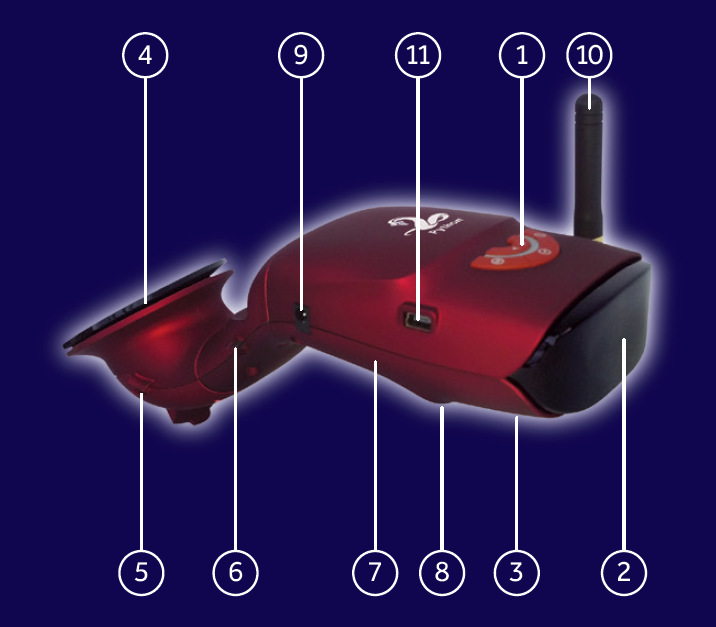Python Overview:
We have designed our Python detectors to help you drive more safely and also make you more aware of your surrounding environment by providing a warning signal that alerts you when you enter areas where emergency services vehicles may be operating:
"Python detectors provide you with real-time feedback when it detects a transmitted signal from an Emergency Service Vehicle by warning you with both a visual and audible alert"
Python detectors are a radio frequency power detectors. It will detect stationary, mobile and emergency services vehicles that are nearby but may not be in your direct line of sight:
"Python detectors will also help to ensure speed awareness. The warning alert from the Python Detector is especially useful to remind the driver keep to the speed limit"
Pythons Key Benefits:
1. Python detectors can be used out-of-the-box, so you can benefit from all the features within minutes.
2. Python detectors do not need and special software to be downloaded or registration process before they can be used.
3. Python detectors can easily be transferred between different vehicles within minutes without the need of any special tools.
4. Python detectors can be powered from its own internal battery and also recharged using the vehicles auxiliary power.
5. Python detectors do not provide any transmitted signal and cannot be detected by other Emergency Service Vehicles.
Pythons Key Features:
✔ Python detectors provide 360 degrees of detection
✔ Detection sensitivity can be adjusted to different brightness levels
✔ Visual alert can be adjusted to different levels
✔ Visual display can be turned off for use at night
✔ Audio alert has a number of different modes
✔ Detectors can be powered from their own internal battery
✔ Supplied with a 12V DC in car power and charging lead
✔ Supplied with a standard RF antenna
✔ Fully integrated windscreen mounting bracket
✔ Built-in Expansion port for additional features
Pythons Product Features:
1. User interface
2. Visual display
3. Audible alert
4. Integrated windscreen mounting bracket
5. Cable retainers
6. Adjuster screw
7. Internal battery
8. Magnetic Interface
9. Power input connector (12V DC)
10. Standard antenna and connector (SMA)
11. Expansion port (USB Mini-B)
Pythons Product Features Descriptions:
1. User Interface:
The user interface is located on the top of the detector. There are 5 buttons having the following functions:
- Power: ON / OFF
- Sensitivity: Adjustable to different levels
- Audio: ON / OFF
- Brightness: Decrease
- Brightness: Increase
2.Visual display:
The visual display is located at the front of the detector and allows the visual alerts to be seen in your peripheral vision. The visual display has 7 coloured LEDs indicating the following:
- RED LED: Power ON/OFF
- BLUE LED's: Sensitivity Level 1 to 5
- GREEN LED (P2/IB Only): Booster Module Sensitivity Level 6 (Available with the optional Python P2 Power Booster Module)
- GREEN LED (P3 Only): Multiple Detection Alert will be illuminated when 3 separate emergency service signals are detected within 45 seconds.
The visual display will be activated after the power button is pressed and the detector has completed its self-test session.
3.Audio Alert:
The audio alert is located on the underside of the detector. The audible alert can be adjusted to a number of different settings from the user interface:
- Alert: OFF
- Alert: ON
- Alert: Repeat Modes (Not available with Python P1)
4. Windscreen Mounting Bracket:
The detector has a unique and fully integrated windscreen mounting bracket located at the rear of the detector for securely fitting the detector to the vehicles windscreen.
5 . Cable retainers:
The detector’s windscreen mounting bracket has two built-in cable retainers that allow the power lead and other cables to be neatly secured to the detector.
6. Adjuster screw:
The detector’s windscreen mounting bracket has an adjuster screw that allows the viewing angle of the visual display to be easily adjusted and locked in position.
7. Internal Battery:
The internal battery allows you to use the detector when it is not connected to the vehicle’s auxiliary power socket.
8. Magnetic Interface:
The detector has a magnetic interface located on the underside of the detector. This allows the connection of other accessories to the detector.
9. Power Input Connector:
The detector has a 12V DC Power Socket located on the left hand side of the detector that allows it to be powered from the vehicles auxiliary power socket using the in car charging lead which is supplied with your detector.
10. Standard Antenna and Connector:
The detector has an external SMA antenna socket located on the right hand side of the detector. This connection point is used to connect the standard RF antenna which is supplied with your detector.
11. Expansion Port:
The detector has an USB Mini-B expansion port located on the left hand side of the detector.
This connection point allows for additional modules to be plugged into the detector to provide increased features such as:
- Python P2 = Support optional Power Booster Module
- Python P3 = Support optional Remote Display Header
Python Detectors Technical Specification:
1. Rated input: 11.8-14.4V DC
2. Radio frequency power detector range: 380-385 MHz
3. Standard operation: 0ºC to +45ºC
4. Short-term storage: -20ºC to +60ºC
5. Long-term storage: -20ºC to +25ºC
6. Width: 64mm (excluding antenna)
7. Height: 40mm (excluding mounting bracket )
8. Length: 220mm (including mounting bracket)
9. Weight: 162 g
10. Power consumption (Standby): 300mW
11. Power consumption (In-use): 550mW
12. Power lead rating: 250mA
13. Battery: Lithium-Polymer
14. Battery operational mode: 2.5 hours
Python Accessories:
Your Python detectors can be upgraded with a number of accessories to improve the detection range and also to mount your detector or upgraded antenna in a different location:
- Higher RF gain RF antenna: The standard antenna can be upgraded to a higher RF gain antenna. This can increase the detection range of the device by approximately 50%.
- Python P2 Power Booster Module: The detection range can also be increased on the P2 Python Detector by upgrading to a plug in “power booster module”, this fits into the expansion port and this can increase the detection range of the device by approximately 25%.
- Dash Mount: The detector can also be mounted on the dashboard or centre console, by using the self-adhesive magnetic mount that connects to the underside of the detector.
- 12V DC DC Charging Lead (In-Car Use): The Python detector can be charged from the vehicles auxiliary power socket using the in car charging lead which is supplied with your detector. Should you need an additional 12V DC Power Charging Lead you can obtain these from our store to ensure you have the corrector Charging Lead for your detector.
- 240V AC/ 12V DC Charging Lead (Home-Use): The Python detector can be charged at home using our Mains Plug Adapter. This device allows you to connect the 12V DC Charging Lead to a standard UK mains outlet allowing you to charge your detector at home ready for your next journey.
- Replacement Standard RF Antenna: The Python detector is supplied with a Standard RF Antenna.
- Extension Cable for Higher RF Gain Antenna: Should you wish to mount the Higher RF Gain windscreen antenna in a different location, for example your rear window, then you can obtain our 5 metre extension cable.
Important Information:
- Python detectors do not provide radio frequency signal demodulation and do not recover any received information content from a modulated radio frequency signal.
- Python detectors are a radio frequency power detectors and will provide an audio and visual alert when it detects an emergency service transmitted radio frequency signal.
- Python detectors are a passive detector and they do not provide any transmitted radio frequency signal and therefore cannot be detected by other emergency service vehicles.
- Python detectors operates in the radio frequency range of 380-385 MHz. Frequencies used by the emergency services may from time to time be subject to change due to government and regularity legislation, therefore we cannot guarantee that our products will continue to operate by detecting emergency service transmitted radio frequency signals should the frequency allocations change outside the units detection range. For the latest information on countries where your Python detectors can operate see our website at: www.pythondetectors.com/where-can-i-use-python
"Please use our detectors responsibly and always abide by local country laws and regulations when using the detectors and when driving a motor vehicle"




